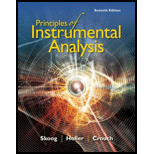
Concept explainers
(a)
Interpretation:
Comparison of ratio of atoms or ions in 3p states and in ground state of Na atom and Mg+ is to be done when there is a natural gas air flame of temperature 1800 K.
Concept introduction:
Boltzmann equation is used for the calculation of the ratio. This equation tells that how much an atom or ion is populated as a function of temperature. This equation is given as-
And the calculation of energy of atom and ion is done by the following formula-
Where,
h= Planck’s constant
c = light velocity
λ= wavelength
Ej= energy difference of excited state and ground state
(b)
Interpretation:
Comparison of ratio of atoms or ions in 3p states and in ground state of Na atom and Mg+ is to be done when there is a hydrogen - oxygen flame of 2950K.
Concept introduction:
Boltzmann equation is used for the calculation of the ratio. This equation tells that how much an atom or ion is populated as a function of temperature. This equation is given as-
And the calculation of energy of atom and ion is done by the following formula-
Where,
h= Planck’s constant
c = light velocity
λ= wavelength
Ej= energy difference of excited state and ground state.
(c)
Interpretation:
Comparison of ratio of atoms or ions in 3p states and in ground state of Na atom and Mg+ is to be done when there is an inductively −coupled plasma source of 7250 K.
Concept introduction:
Boltzmann equation is used for the calculation of the ratio. This equation tells that how much an atom or ion is populated as a function of temperature. This equation is given as-
And the calculation of energy of atom and ion is done by the following formula-
Where,
h= Planck’s constant
c = light velocity
λ= wavelength
Ej= energy difference of excited state and ground state.
Trending nowThis is a popular solution!

Chapter 8 Solutions
Principles of Instrumental Analysis
- a. H3C CH3 H, 1.0 equiv. Br2arrow_forwardH3C. H3C CH 3 CH 3 CH3 1. LDA 2. PhSeCl 3. H2O2arrow_forwardPlease predict the products for each of the following reactions: 1.03 2. H₂O NaNH, 1. n-BuLi 2. Mel A H₂ 10 9 0 H2SO4, H₂O HgSO4 Pd or Pt (catalyst) B 9 2 n-BuLi ♡ D2 (deuterium) Lindlar's Catalyst 1. NaNH2 2. EtBr Na, ND3 (deuterium) 2. H₂O2, NaOH 1. (Sia)2BH с Darrow_forward
- in the scope of ontario SCH4U grade 12 course, please show ALL workarrow_forwardIs the chemical reaction CuCl42-(green) + 4H2O <==> Cu(H2O)42+(blue) + 4Cl- exothermic or endothermic?arrow_forwardIf we react tetraethoxypropane with hydrazine, what is the product obtained (explain its formula). State the reason why the corresponding dialdehyde is not used.arrow_forward
- drawing, no aiarrow_forwardIf CH3COCH2CH(OCH3)2 (4,4-dimethoxy-2-butanone) and hydrazine react, two isomeric products are formed. State their structure and which will be the majority.arrow_forward+ Reset Provide the correct IUPAC name for the compound shown here. 4-methylhept-2-ene (Z)- (E)- 1-6-5-2-3-4- cyclo iso tert- sec- di tri hept hex oct meth eth pent ane yne ene ylarrow_forward
 Principles of Modern ChemistryChemistryISBN:9781305079113Author:David W. Oxtoby, H. Pat Gillis, Laurie J. ButlerPublisher:Cengage Learning
Principles of Modern ChemistryChemistryISBN:9781305079113Author:David W. Oxtoby, H. Pat Gillis, Laurie J. ButlerPublisher:Cengage Learning

